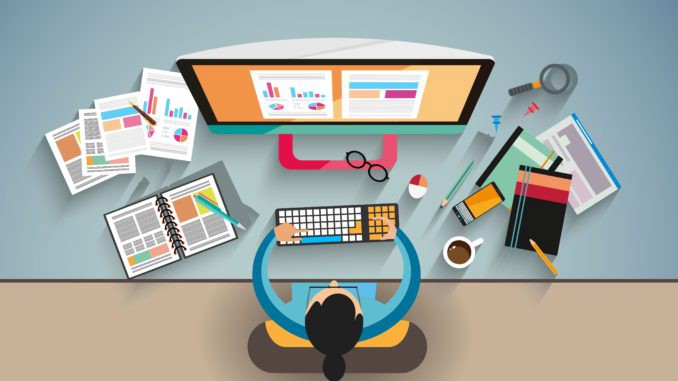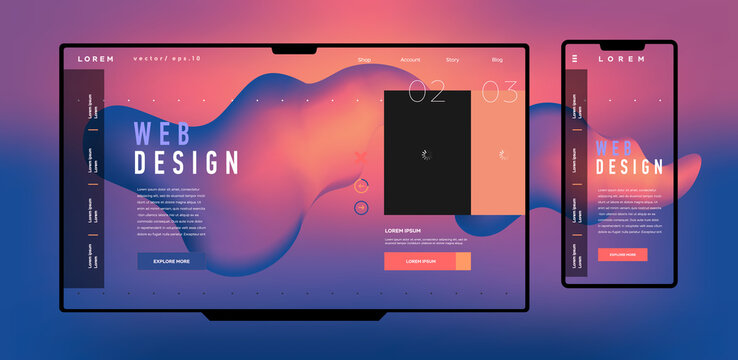Comprehending the Crucial Element That Make up Effective Web Design Techniques
When it concerns website design, recognizing the crucial elements can make all the distinction in individual engagement and complete satisfaction. You require to consider aspects like instinctive navigation and responsive layout to produce a seamless experience. That's simply the begin. Each component plays an important duty in leading customers via your web content and affecting their behavior. Curious regarding what actually drives these strategies? Let's check out deeper right into these essential elements.
The Value of User Experience (UX) in Website Design
Customer experience (UX) is the backbone of efficient web style, forming exactly how site visitors engage with your site. When you prioritize UX, you develop a space where individuals feel comfortable, involved, and valued. A well-designed UX warranties that your audience can quickly navigate your web content, discover information swiftly, and appreciate their general experience.You should consider your users' choices and needs, as this understanding directly influences their satisfaction. By concentrating on elements like lots times, mobile responsiveness, and ease of access, you enhance their experience considerably.Moreover, a favorable UX cultivates depend on and encourages repeat visits, which can bring about greater conversion rates. Remember, individuals will not hesitate to leave your site for a competitor if they come across aggravation or confusion. Inevitably, spending in UX isn't almost looks; it has to do with developing a user-centric design that keeps visitors returning for more.
Crafting Intuitive Navigation for Seamless Browsing
When designing a site, crafting user-friendly navigating is necessary for assuring site visitors can locate what they require without aggravation. Begin by arranging your web content realistically; group associated web pages with each other to aid users forecast where to locate details. Usage clear, succinct tags for navigation links, avoiding jargon that could confuse your audience.Consider implementing a hierarchical framework with a major food selection and dropdowns for subcategories, making it very easy to pierce down right into details subjects. Integrate a search bar to empower users to locate material directly, especially on bigger sites.Don' t neglect concerning mobile individuals; establish your navigating stays obtainable on smaller screens. Keep it easy and regular throughout all web pages to enhance knowledge. By concentrating on these aspects, you'll develop a seamless surfing experience that maintains visitors involved and encourages them to discover more of what you need to provide.
Receptive Style: Adapting to Different Devices
As the selection of devices individuals utilize to access the internet remains to grow, guaranteeing your web site is responsive has actually never been more vital. A receptive style implies your site adapts perfectly to various screen dimensions, from smart devices to desktop computers, supplying a premium viewing experience. This flexibility not just improves individual fulfillment however likewise boosts your site's performance in internet search engine rankings.To develop a responsive layout, use adaptable grids and designs that instantly change to the display's dimensions. Implement CSS media questions to personalize designs based upon device features. Prioritize necessary material, ensuring it's easily available on smaller sized displays without overwhelming individuals.
The Function of Visual Power Structure in Effective Layouts
Visual hierarchy is necessary for guiding your audience's attention where it matters most. By successfully making use of focal factors, typography, shade, and comparison, you can create a design that interacts your message clearly. Let's check out just how these components interact to improve your style.
Relevance of Focal Points
Prime focus are essential in website design, directing individuals' attention to one of the most crucial components on a web page. By tactically positioning these focal points, you produce a clear visual pecking order that boosts user experience. Consider what you desire your visitors to observe first-- whether it's a call-to-action switch, an essential photo, or significant information.Using dimension, placement, and comparison, you can attract focus to these focal factors, making them attract attention. Bear in mind, the extra noticeable the focal factor, the a lot more most likely customers are to involve with it. A properly designed layout not just records interest yet also leads customers via your material flawlessly, ensuring they take in the info that matters most. Prioritizing focal factors is important for effective interaction on your site.
Shade and Comparison Usage
Reliable use color and contrast can considerably affect exactly how customers regard your site's material. By choosing a shade combination that straightens with your brand name, you produce a psychological link with site visitors. High contrast in between message and background boosts readability, guaranteeing your message sticks out. Use contrasting colors to highlight essential elements, like call-to-action switches, assisting individuals' focus where it matters most.Additionally, balance is crucial; also much contrast can be overwhelming, while inadequate might render your content unseen. Implementing an aesthetic hierarchy with shade assists customers navigate your website intuitively. You desire them to quickly compare headings, subheadings, and body text, which boosts their general experience. Eventually, effective color and comparison use maintains customers involved and motivates them to explore further.
Typography's Impact on Layout
While it's simple to forget, typography plays a vital role in shaping your web site's layout and total user experience. It establishes an aesthetic pecking order that overviews site visitors via your content. By selecting the best typefaces, dimensions, and styles, you can emphasize vital details and develop a seamless flow. Utilizing larger headings helps users promptly identify areas, while smaller body text gives thorough understandings without frustrating them. Consistent typography not just improves readability yet likewise reinforces brand name identity. Keep in mind to stabilize attractive fonts with legibility to maintain professionalism. Ultimately, effective typography warranties your message reverberates, making your internet site extra easy to use and engaging. Prioritizing this element can significantly boost your design approach and impact.
Utilizing Compelling Web Content to Involve Site Visitors
How can you maintain your visitors involved and coming back for even more? The answer lies in compelling web content. Start by recognizing your audience and what rate of interests them. Develop informative posts, enthralling stories, or enjoyable videos that reverberate with their needs. Use a conversational tone to make your material relatable; it needs to feel like a friendly conversation instead of a lecture.Incorporate visuals like pictures, infographics, and video clips to break up text and keep points dynamic. Don't neglect to welcome interaction-- ask concerns, encourage comments, or consist of polls to spark discussions.Also, prioritize clearness and conciseness. Make certain your primary points shine through without unneeded lingo or fluff. Keep in mind, high quality over quantity issues; it's far better to have fewer, high-impact pieces than a slew of sub-par ones. Ultimately, when your content's appealing, site visitors will not just linger but also share it with others.
The Impact of Shade Psychology on Customer Interaction
When you pick shades for your site, consider exactly how they can influence individual emotions and understandings. Shades can boost your brand identity while also making sure access with contrast. Understanding these elements can substantially enhance customer communication and interaction.
Color Meanings and Emotions
Understanding color psychology is crucial for creating an engaging web style, as the shades you choose can evoke details emotions and affect customer communications. Various shades can activate different sensations; as an example, blue typically shares trust and peace, while red can stimulate enjoyment or urgency. When you include these shades thoughtfully, you guide your users toward desired activities. Yellow can motivate optimism and happiness, making it reliable for phone call to action, while green advertises relaxation and a link to nature. By straightening your color combination with the emotions you want to elicit, you enhance user experience. Consider your target market and the message you wish to convey, ensuring your color options resonate and produce a long-term effect.
Brand Identity Via Color Styles

Shade Contrast and Availability
While selecting a color scheme is important, assuring ample comparison website is crucial for accessibility. You want your site to be visually enticing, however it ought to additionally accommodate all users, including those with aesthetic disabilities. High contrast between text and history enhances readability, making it easier for everyone to involve with your content.Think concerning color psychology, as well. Different colors evoke various emotions and reactions. By recognizing just how colors effect user interaction, you can direct users towards desired activities. Making use of warm colors can produce urgency, while great colors could impart calmness. Constantly test your shade combinations to verify they meet availability criteria, helping you produce a comprehensive experience that resonates with all visitors.
Optimizing Lots Rate for Enhanced Performance
Considering that customers expect web sites to fill quickly, optimizing lots rate is important for boosting performance and user fulfillment. A slow-loading website can annoy site visitors and drive them away, so you need to take action. Start by compressing photos and using modern formats like WebP. This can significantly reduce file dimensions without compromising quality.Next, lessen HTTP requests by incorporating CSS and JavaScript files. Fewer demands mean quicker load times (website design london Ontario). Carrying out careless packing for pictures and videos guarantees that content lots only when users scroll down, boosting first tons speed.Additionally, leverage browser caching to keep frequently accessed resources, enabling repeat visitors to enjoy much faster loading times. Select a trusted organizing company. Their performance directly affects your website's speed
Regularly Asked Inquiries
How Can I Determine the Effectiveness of My Website Design Strategy?
To gauge your website design technique's performance, track customer involvement metrics like bounce prices, conversion prices, and typical session period. Use tools like Google Analytics to collect understandings and adjust your approach based upon the data.
What Are Usual Errors to Stay Clear Of in Internet Layout?
In internet design, prevent chaotic designs, inconsistent font styles, and sluggish loading times (website design london Ontario). Do not ignore mobile responsiveness or forget user screening. Focus on accessibility and guarantee clear navigating to enhance user experience and keep visitors involved
Exactly how Often Should I Update My Internet Site Style?
You should update your internet site design every 1 to 2 years, or whenever significant adjustments happen in your brand or industry. Regular updates keep your site fresh, boost customer experience, and improve functionality.

What Equipment Can Assist Analyze Individual Habits on My Website?
To evaluate customer behavior on your site, you can make use of devices like Google Analytics, Hotjar, or Crazy Egg. They'll give insights right into user communications, aiding you make informed decisions for improving your web site's efficiency.

Exactly how Do I Pick the Right Font for My Web site?
Choosing the ideal font style for your internet site includes taking into consideration readability, design, and placement with your brand name. Experiment with different fonts, verify they're understandable on various devices, and keep consistency throughout your pages for a cohesive appearance. Incorporate a search bar to encourage individuals to locate content directly, specifically on bigger sites.Don' t forget regarding mobile customers; identify your navigation remains available on smaller sized screens. Effective usage of color and contrast can significantly influence exactly how customers view your site's content (website design london Ontario). Understanding color psychology is important for creating an engaging web style, as the colors you pick can influence and evoke details feelings user interactions. By recognizing just how shades influence customer communication, you can assist customers toward wanted actions. Given that users expect sites to pack promptly, maximizing lots rate is critical for boosting efficiency and user satisfaction